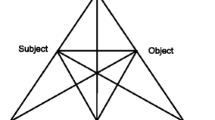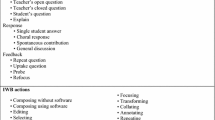Abstract
Interactive whiteboards (IWB) are an innovation that is gaining considerable presence in many contemporary classrooms. This paper examines the use of IWBs in mathematics classrooms. Using a productive pedagogies framework to analyse classroom videos, it is proposed that the classrooms observed used a restricted approach in their use of IWBs. It was found that they were used for quick introductions to lessons and whole class teaching. They were also teacher directed and fostered shallow learning. Through interviews with the teachers, it was found that the approaches observed were based on assumptions about learners and technology.
Similar content being viewed by others
References
Armstrong, V., Barnes, S., Sutherland, R., Curran, S., Mills, S., & Thompson, I. (2005). Collaborative research methodology for investigating teaching and learning: The use of interactive whiteboard.Educational Review, 57(4), 457–469.
Beauchamp, G. (2004). Teacher use of the interactive whiteboard in primary schools: towards an effective transition framework.Technology, Pedagogy and Education, 13(3), 337–348.
Education Queensland. (2001).The Queensland school longitudinal reform study. Brisbane: GoPrint.
Edwards, J.-A., Hartnell, M., & Martin, R. (2002). Interactive whiteboards: Some lessons from the classroom.Micromath, 18(2), 30–33.
Engestrom, Y. (1999). Activity theory and individual and social transformation. In Y. Engestrom, R. Miettinen, & R-L. Punamaki (Eds.),Perspectives on activity theory (pp. 19–38). Cambridge, UK: Cambridge University Press.
Glover, D., & Miller, D. (2001). Running with technology: The pedagogic impact of the large-scale introduction of interactive whiteboards in one secondary school.Journal of Information Technology for Teacher Education, 10(3), 257.
Glover, D., & Miller, D. (2002). The interactive whiteboard as a force for pedagogic change: The experience of five elementary schools in an English education authority. InInformation Technology in Childhood Education (Vol. 1, pp. 5–19). Norfolk: Association for the Advancement of Computing in Education.
Glover, D., Miller, D., Averis, D., & Door, V. (2005). The interactive whiteboard: A literature survey.Technology, Pedagogy and Education, 14(2), 155–170.
Griffenhagen, C. (2000).A report into whiteboard technologies: A published report. Oxford: Computing Laboratory.
Jones, S., & Tanner, H. (2002). Teachers’ interpretations of effective whole-class interactive teaching in secondary mathematics classrooms.Educational Studies, 28(3), 265–274.
Latane, B. (2002). Focused interactive learning: A tool for active class discussion.Teaching of Psychology, 28(1), 10–16.
Leont’ev, A. N. (1981). The problem of activity in psychology. In J. V. Wertsch (Ed.),The concept of activity in soviet psychology (pp. 37–71). Armonk, NY: Sharpe.
Lerman, S., & Zevenbergen, R. (2006). Maths, ICT & pedagogy: An examination of equitable practice across diverse settings. In J. Novotná, H. Morová, M. Krátká, & N. Stehliková (Eds.),Proceedings of the 30th conference of the International Group for the Psychology of Mathematics Education (Vol 4, pp. 49–56.). Prague, Czech Republic: PME.
Maor, D. (2003). The teacher’s role in developing interaction and reflection in an on-line learning community.Educational Media International, 401(1/2), 127–138.
Morgan, C. (1994). The computer as catalyst in the mathematics classroom? In S. Lerman (Ed.),Cultural perspectives on the mathematics classroom (pp. 115–131). Dordrecht, The Netherlands: Kluwer.
Newmann, F., & associates. (1996).Authentic achievement: Restructuring schools for intellectual quality. San Fransisco: Jossey-Bass.
Schmid, E. C. (2006). Investigating the use of interactive whiteboard technology in the English language classroom through the lens of a critical theory of technology.Computer Assisted Language Learning, 19(1), 47–62.
Smith, F., Hardman, F., & Higgins, S. (2006). The impact of interactive whiteboards on teacher-pupil interaction in the National Literacy and Numeracy Strategies.British Educational Research Journal, 32(3), 443–457.
Wall, K., Higgins, S., & Smith, H. (2005). “The visual helps me understand the complicated things”: Pupil views of teaching and learning with interactive whiteboards.British Journal of Educational Technology, 36(5), 851–867.
Waycott, J., Jones, A., & Scanlon, E. (2005). PDAs as lifelong learning tools: An activity theory based analysis. Learning,Media & Technology, 30(2), 107–130.
Zevenbergen, R., & Lerman, S. (2007). Pedagogy and interactive whiteboards: Using an activity theory approach to understand tensions in practice. In K. Beswick & J. Watson (Eds.),Mathematics: Essential research, essential practice (Proceedings of the 30th Annual Conference of the Mathematics Education Research Group of Australasia, Hobart, Vol. 2, pp. 853–864). Adelaide: MERGA.
Author information
Authors and Affiliations
Rights and permissions
About this article
Cite this article
Zevenbergen, R., Lerman, S. Learning environments using interactive whiteboards: New learning spaces or reproduction of old technologies?. Math Ed Res J 20, 108–126 (2008). https://doi.org/10.1007/BF03217471
Published:
Issue Date:
DOI: https://doi.org/10.1007/BF03217471




